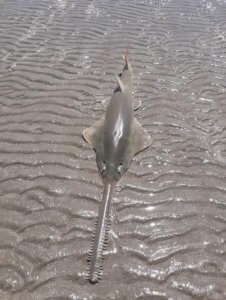Traditional owners have found a protected narrow sawfish, a number of sharks and other fish dead on a beach and in shallow waters following an incident in which a number of gillnets were set and apparently left for a period of days in a remote area of the western Cape York Peninsula.
Mapoon resident Eli Tabuai discovered the dead and rotting marine wildlife when he went to Namaleta Beach to hunt for mud crabs and stingrays.

This protected narrow sawfish was found dead on Namaleta Beach by Eli Tabuai (Pic: Eli Tabuai)
Mr Tabuai said: “We believe in only taking enough to feed your family. If there is extra, you share it with your community. Gillnet fishing only targets barramundi but other species are caught and as we saw in this case, there’s a lot that goes to waste.”
His grandmother, Warrangku elder Delora Nixon, who is a board member of the Old Mapoon Aboriginal Corporation (OMAC), added: “We benefit from this sea country because it is like our supermarket but we believe strongly we must fish it sustainably and safely and only take what we need.”
Going on Mr Tabuai’s account and his pictures, the Australian Marine Conservation Society (AMCS) suspects the fishes died as a result of the gillnetting. The Queensland Government must improve consultation with Traditional Owners and tighten gillnet fishing rules. Urgent improvements such as net attendance rules, restricting the length of time nets are left in the water, and urgently implementing on-board cameras on all gillnet fishing boats are necessary tools to help threatened species populations recover in the Gulf of Carpentaria.
Dr Leonardo Guida, shark scientist with AMCS said: “This incident follows hot on the heels of three separate reports of turtle and sawfish deaths linked to gillnets in Queensland in only a matter of months. The Queensland Government can’t keep turning a blind eye, while the fisheries they manage push them closer to extinction.
“Northern Queensland is a global stronghold for endangered and critically endangered species of sawfish. The Queensland Government must improve consultation with Traditional Owners, particularly when it’s about protecting critical habitats like the Port Musgrave region, where this sawfish was found.
“Gillnet fishing rules must be improved so that fishers can better avoid and safely release bycatch quickly. At present, fishers can be nearly 10km from their nets, how can they have any idea what is being caught? Commercial fishers should be close enough to monitor the gillnets at all times, as well as restrictions placed on the length of time nets can be left in the water.”
Robyn Bartlett, who is CEO of the OMAC, said there appears to have been a lack of consultation by the department of fisheries with Traditional Owners in setting fishing rules and a lack of transparency in the reporting of the catch of non target species like sawfish.
“Traditional owners of this Sea Country should be able to see exactly what species are being caught in gillnets as bycatch. They are asked to protect these lands and sea but how can we do this if we are not provided with all the information.”
Dave Donald, a recreational and charter fishing advocate from Weipa, said all commercial fishers in Queensland should be required to complete a protected species and ethical treatment course which would train them to remove wildlife from their nets.
“Commercial fishers need to be more professional in their activities,” he said.
“There are too many commercial gillnet fishers in Queensland and these latest incidents are just the tip of the iceberg. Wildlife is suffering, not being ethically respected. The Gulf also needs more fisheries officers up here to help police compliance issues. This is an area the size of Victoria with a huge coastline and there are currently only two working fisheries officers.”
AMCS runs a campaign with Humane Society International to drive better protection for sharks and rays, encouraging Australians to become Shark Champions and create healthier oceans. Sign up to Shark Champions at www.sharkchampions.org.au